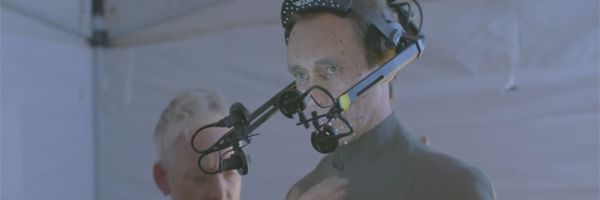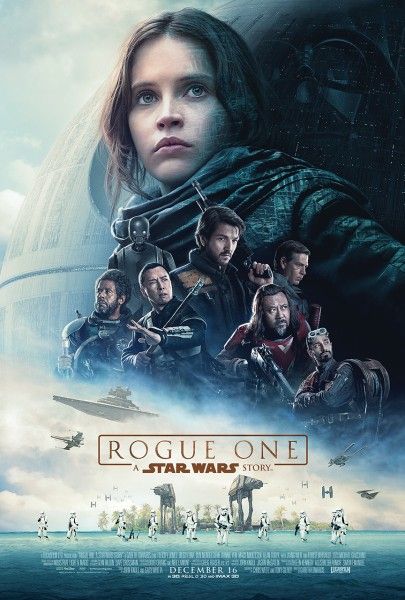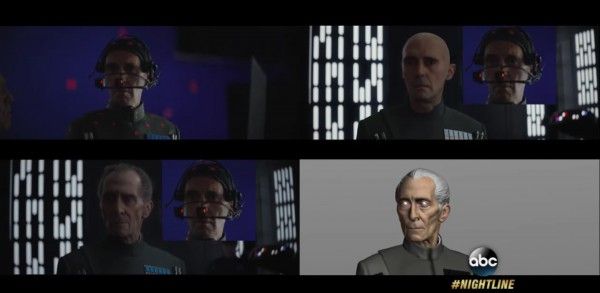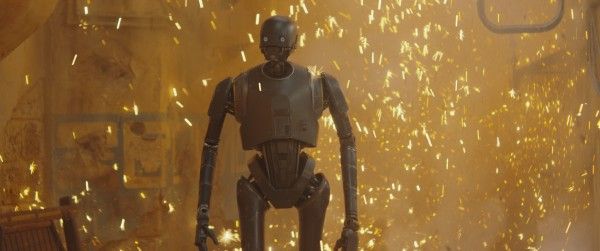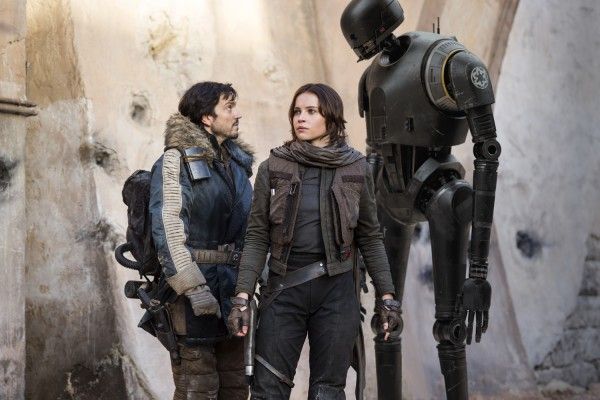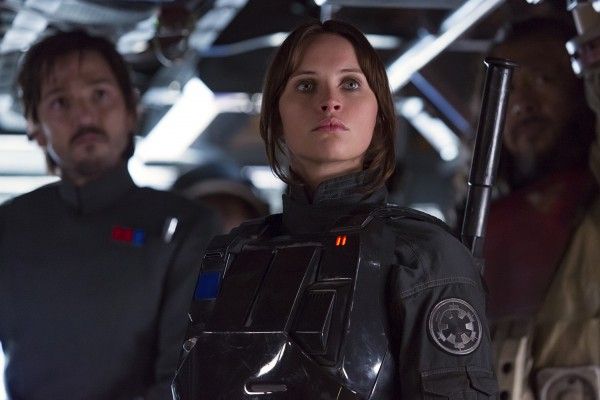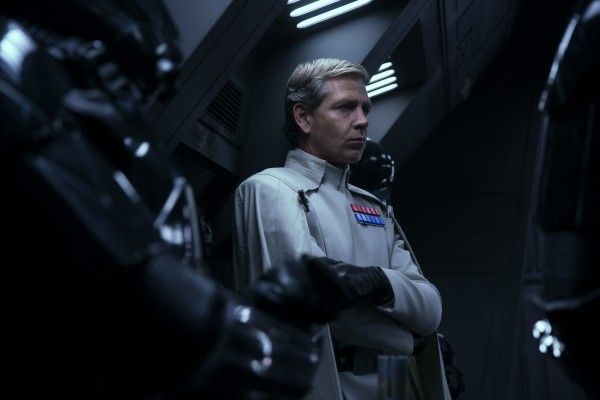Before going any further: Rogue One spoilers are discussed during this interview. You’ve been warned.
Now that Rogue One is playing around the world and fans have had the opportunity to see the latest Star Wars movie, it’s time to dive into the secrets of how the film was made. If you’ve seen the film, you know two of the big surprises were the reveals of a digital Grand Moff Tarkin and Princess Leia. While the film could have been made without the appearance of either of these characters, I’m happy they were included to help tie Rogue One into the greater Star Wars story. Also, when both characters show up on screen, at the screenings I’ve attended fans love it (and some get pretty vocal).
Last week I landed an exclusive interview with John Knoll (who came up with the idea for Rogue One), Hal Hickel and Neil Corbould. They’re the ILM wizards that helped bring the film to life. During the interview they talked about creating the digital characters, how technology has changed over the past few years, making the movie look like it was shot on film even though they used digital cameras, how they kept the secrets of the film under wraps till the world premiere, Easter eggs, and a lot more. If you’re curious about the making of Rogue One I’m pretty confident you’ll enjoy hearing what they had to say.
COLIIDER: I know you’ve been doing interviews for the last few hours, so I wanna start with a fun question. Do guys ever think before a project starts, “We’re fucked”?
[All Laugh]
JOHN KNOLL: On every one. No, I mean –The projects that we’re most attracted to are the ones where there’s some element of the unknown, where there are some aspects of it that we don’t necessarily know how we’re gonna do. Those end up being the most exciting because you apply the ILM method to it where we have a lot of really smart and talented people and we break these problems apart into smaller problems, and it hasn’t failed us yet. These projects where you go in and you’re not quite sure how you’re gonna do it end up being the most exciting and rewarding.
For the three of you, for Rogue One – and I’m gonna get into Tarkin and Leia in a bit– what was the thing that when you guys were breaking it down that made you think, “This is gonna be a real challenge”?
KNOLL: Unfortunately it was self-inflicted but, yeah, the digital humans. At the beginning in my first draft I had the very last moment in the movie was with Leia, and pretty early on in the more detailed story development Gary [Whitta] asked, “How do you feel about Tarkin having a role in the movie?” and I said, “Yeah. Let’s do it, let’s do it” knowing that that’s really hard stuff, digital humans is one of the hardest things in digital graphics, but we were all eager to take on the challenge.
Let’s jump into Tarkin for a second. There’s obviously shots where you could sort of put him more in the shadows, but the movie does a great job with keeping him in the light and making him look like he’s right there. Can you talk about balancing how to bring this character to life and also making him look as real as possible?
KNOLL: Well, I had some long conversations with Greig Fraser who’s our DP about how we should be treating these characters, and I encouraged him to, “Don’t do anything different that you would do if he was right there on set. Let’s not try and script this, let’s just treat him like he’s any other character.” And the first time we see him that was all Gareth, [Edwards, Director] in what I thought was a really very clever stage reveal where it starts off where it’s a small figure that’s out of focus in the background, then we get closer and we’re just seeing the back of his head.
The hope is that you think, “Oh, maybe that’s all they’re gonna show us, the back of his head. Showing his face would be really hard.” But he steps closer to the window and you see his reflection and then, “Ah! I see they’re just gonna show his reflection!” and then when you’re sure they’re just gonna show the reflection, the he turns into the close-up and, “Oh my god! There he is!” And it was all a pretty deliberate stage reveal and shot design that Gareth came up with.
One of the things with the reveals of Tarkin and Leia was that no one really knew. I know that even days before the movie came out people were guessing that maybe this could be possible. How the hell do you keep something like this under wraps when you have so many people working on the film?
KNOLL: Kathy [Kathleen Kenndy, Producer] asked us not to talk about it, so we didn’t [Laughs]. And I trusted my crew. Kathy wanted this to be a surprise for the audience so, “Don’t talk about it in the hallways. Don’t spoil it, don’t spoil the surprise for people.”
All I can say to you guys is that I saw it again recently in 70mm and the highlight of the whole film was the person sitting behind me in the last ten minutes who kept on saying, “Oh my god! Oh my god! No way! No way!” and just freaking out more and more. It was just great.
KNOLL: Good.
For all three of you, what can you do now that you couldn’t do a year, two years, or three years ago? I’m always curious about how technology is shifting.
KNOLL: Well, every film tries to advance the state of the art, at least a little bit. Brand new techniques? A lot of them are just evolutionary, we’re just building on something that’s like something we’ve done before and just trying to do it a little bit better or make it a little bit more realistic. This film is the first time we’ve used a real-time renderer, so our advanced development group has been working on a GPU based, game engine based, renderer to try and generate very high realism images, and we used it in production for the first time on Rogue One. There’s a handful of shots, only a few, that are in the final movie of K-2SO that were rendered on a GPU. And I’m pretty pleased that you can’t spot them, they look just like the other k-2 shots.
HALL HICKEL: For me, it’s not a new thing exactly, but facial capture is becoming much more important in the work that I’m doing as an animation supervisor. I just did Warcraft before Rogue One and that obviously had tons of characters who were via motion capture, from their bodies to their faces, on Rogue we had our digital actor. Learning to work with that and improving the results in terms of fidelity to a real human face and then being able to use it in a form that the animators can edit it and change it and modify it without breaking it, our tools are just getting better and better in that regard. So that, again, something that stepped up even further on this film and will continue to push on future films I’m sure.
NEIL CORBOULD: With the battle sequences we developed an air explosion, like a high-pressure air cannon explosion which we could use very close to, very safely. It was something that I hadn’t used before and developed it for this movie. And just the sheer quantity of pyrotechnics and explosions that we did and with guns firing, just go for it and don’t worry about putting too much smoke and too many explosions.
When did you actually wrap on Rogue One compared to the world premiere?
KNOLL: We delivered the last shot of the movie the day before Thanksgiving.
So it wasn’t at the last possible second, it was just close.
KNOLL: That was the last possible second [Laughs.]
Oh, so it really was.
KNOLL: Well, yeah. I mean, there’s a stereo conversion on the movie as well so the last week of the show I was getting desperate communication from the IMAX folks and the stereo conversion folks to, “You really gotta close out reel 5, you think we’re gonna get this shot today?” So we scrambled until the last second.
For all three of you, what was the last thing, the last shot, or the last sequence that you worked on?
KNOLL: Let’s see… I think the very last shot that was delivered was the shadow reveal of Vader on Mustafar.
HICKEL: For me it was the Leia shot. That was the last thing we were pushing hard on to get in every last bit of work we could get in.
I’m always curious about Easter Eggs, and I know that there must be some in the film that maybe people haven’t found. Is that true?
KNOLL: Yeah, there’s a few. I mean, they’ve found all the major ones but there are little ones. Gareth’s got a cameo but he hasn’t said what it is and I’m not gonna spoil it, but it’s in there and it’s a good one. There’s one –Ok, we did a shot of Krennic’s ship leaving the Death Star, and the design of that shot was really trying to illustrate the scale of the Death Star, how big that thing really is –it’s supposed to be 100 miles in diameter– so I really wanted to try and so I wanted to help the audience viscerally understand how big a 100 mile diameter thing was. So at the beginning of the shot you can see there’s an equatorial trench, you can see these docking bays there, and there’s just enough scale cues to give you some idea of how big that really is. The equatorial trench is almost a half a mile tall and it’s big enough that you can dock a Star Destroyer there somewhere. Talking with Russell Paul who’s my model supervisor on the show we thought, “Well shouldn’t there be a giant docking bay somewhere in that trench where you could park a Star Destroyer in?” and so you look in that shot and about half way back in the trench there’s a giant docking bay with a Star Destroyer parked in it. And I don’t think anyone’s picked up on that one yet.
I was gonna say I definitely didn’t notice that, but I will absolutely look at it the next time I see the film.
KNOLL: Alright.
When you guys do stuff like that, how much is that you decision on your own like, “We’re putting this in” and how much is that going up the food chain to Gareth and anybody else saying, “Hey we wanna do this, what do you think?”?
KNOLL: In that case I just decided it would be a cool thing to do and so we did it.
I like that. Star Wars fans like me of course want to know everything, and that’s a cool Easter Egg, but are there any other surprises that people might be surprised to learn about the making of the film or your work on the film, maybe on characters? I’m always curious about little stories behind the scenes.
KNOLL: There are things that I really enjoyed about this production. At the beginning of the film there was a cranial discussion about whether we should shoot on film or digitally, and I know that Gareth really loves the look of film, he wanted the movie to be beautiful; I’ve done plenty of projects on film. But there are a bunch of reasons why I really wanted to shoot digitally, for the more stable color imagery, the better ratio, and those sorts of things.
I thought that we could get the best of both worlds, we could shoot digitally but I could make it look like film. And it’s something that we’ve been doing for years, you have to mix images from multiple different sources, even stuff that we’re shooting on film, we’ll shoot elements like with Canon digital scope cameras to use as part of mapping and backgrounds or for textures on props. And we need to get them all to be on the same color space, so we very carefully characterize the different cameras that we use in different recording media, and when we record imagery into our system we very carefully linearize all of it and then we work in that linear space and we invert the color transform on the way out.
Something that I don’t think has ever been done before and that I proposed doing is this picture was, “Well, why don’t we just bring in all the Alexa footage as we do normally but we’ll put it out with the film curve” and so the entire movie has got a 52-30 film emulation light on it. And I thought that was pretty successful in kind of getting us the best of both worlds. I think we’ve gotten pretty good notices for people liking the look of the film.
I’m giving you a thumbs up, I agree. What about for Hal and Neil?
HICKEL: Are we talking about the highlights of the process for us now or…?
It could be the highlights or just something surprising behind the scenes that fans might appreciate, like that story about learning that it was all shot digitally but with a film add-on, that’s a really cool thing. I’m basically trying to give fans more knowledge about the making of the film and what might surprise them to learn, or it could be the highlight of the production for you.
HICKEL: I really enjoyed working with Alan Tudyk on this film, it was really fun. He’s great and he’s super funny improvisational actor, and he has the space there to come up with some lines on his own and to improvise. That was great, and if you look closely when he slaps Diego [Luna] in Jedha, if you look carefully, Diego actually starts lo laugh, he covers up his face with his hand when he starts to laugh in that shot. I think that’s terrific, I liked it a lot. Alan was always coming up with great stuff like that.
CORBOULD: At the beginning it was great when I had the first meeting with Gareth, and he just said, “I want a war movie. It’s called Star Wars, so it’s got to be about war” and he wanted me to bring all my experience from like Saving Private Ryan and Black Hawk Down into the Star Wars universe. That was a great challenge and a great lot of fun to do, creating different explosions, different paths but trying to keep to the original of A New Hope, that look but just take it a little step further.
I give all three of you huge props, I think the movie is fantastic. Then again, worldwide I hear it’s doing ok.
KNOLL: [Laughs] it is doing ok.
HICKEL: It’s doing alright, yeah. Our friends at Disney are happy.
For John, I’m curious, you came up with this idea and pitched it to Kathy –And you might have answered this already, but I’m gonna ask anyway. How much does the finished film look to what you originally pitched in the room that day?
KNOLL: Obviously these things evolve as you work on them pretty significantly, but about half of it is the same. All the major characters are all the same characters I pitched.
Can I ask if you remember that moment you came up with the idea, do you remember where you were, or when it was that all of a sudden it just germinated in your head that you were like, “I want to see this”?
KNOLL: Yeah that was actually quite a long time ago. When we were shooting on Episode III in Sydney in the summer of 2003, I was on set with Jonathan Rinzler who was the editor of Lucas Books at the time he was there while gathering information for writing the making of Episode III, and we were chatting and he had mentioned that George [Lucas] and Rick [McCallum] were developing this live-action Star Wars TV show and there had started to be story development. That got me thinking about what kind of fun stories would be appropriate material for a live-action Star Wars TV show, and one of the first thoughts was about that opening crawl in A New Hope, the spy mission to steal the Death Star plans, and I started imagining a Mission Impossible-like team of Rebel commandos that are trying to penetrate the most secure facility in military industrial complex of the Empire to steal the plans. And I started tinkering with those ideas and then a few days later I was chatting with Rick and I asked him about the TV show and he said, “Oh yeah, let me tell you” and he told me about the era and the general themes of the show and I realized that this idea had no place within that show. And so I dropped it, and it really wasn’t until Kathy came to Lucasfilm and they announced this new slate of films in addition to Episodes VII, VIII, and IX continuing the Skywalker saga and that they were gonna do these standalone stories that were adventures that took place in the Star Wars universe that I thought, “Hey, that idea of doing the Death Star plans spy mission, that could make a pretty good feature film” and that’s sort of where it came from.
When you’re in the room with Kathy and your pitching her this idea, do you get the vibe at that moment that she’s just sort of seeing you to be nice? Do you know what I mean? Because I’ve heard Kathy say that she was nervous that everyone was gonna start pitching her ideas now. I’m just curious what it was like in the room when you’re going in for a pitch, have you pitched many movies?
KNOLL: No, no, that’s it.
[Laughs] So you’re one for one.
KNOLL: I definitely got the sense that she was humoring me, but she took it seriously and I had her full undivided attention and I went for it. I left the meeting and I didn’t hear anything for a few days and I thought, “Well, at least I did it. I won’t ever wonder what would’ve happened if I’d done it.” About a week later I got a call from Kiri Hart, the head of Lucasfilm Story, and she said, “We’ve been talking a lot about this and we may want to proceed with it” and so it snowballed from there. That’s something very nice about Lucasfilm, that the climate exists that things like that can happen.
That’s how Pixar works, all those people work together as a team to create the best possible thing.
KNOLL: Yeah, I’ve often said that one of the things I love about ILM is that a good ideas is a good idea no matter where it comes from. We have this sort of open atmosphere where people if they have a good ideas they should just say it.
I’m gonna say thank you so much and congratulations to the three of you, the movie is so good.

